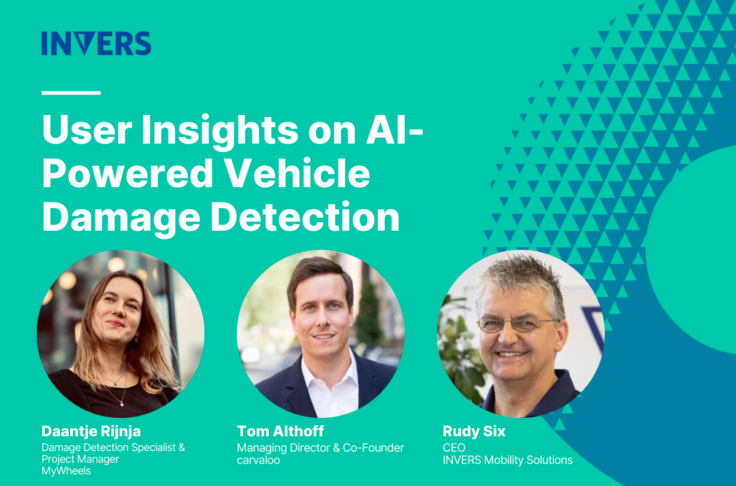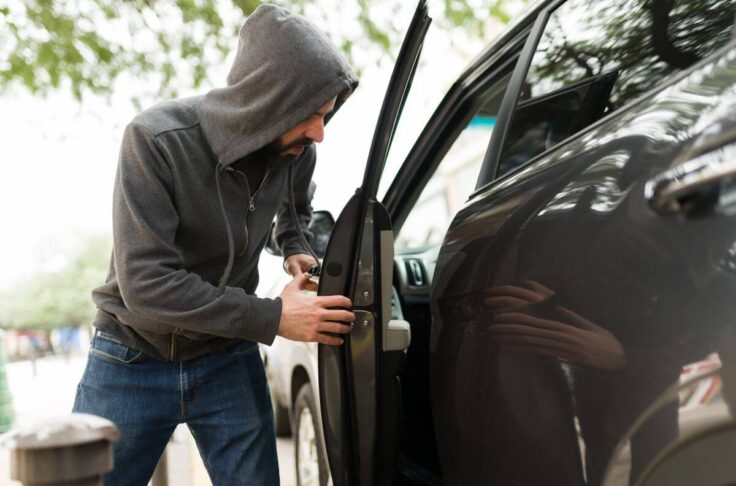Top 5 Solutions For Car Damage Detection

Accidents happen and vehicles are damaged in every sharing fleet. Some damages remain undetected for a long time, entailing expensive repair costs and jeopardizing customers’ safety. Fortunately, there exist car damage detection solutions to help fleet operators stay up-to-date on their vehicles’ statuses and keep them in good running and repaired condition.
Below we evaluate five different car damage detection techniques and solutions. From traditional low-tech solutions to state-of-the-art AI car damage detection, this article describes each one’s pros and cons and the type of operations they’re best suited for.
Key Takeaway
There’s a wide variety of car damage detection solutions. Their benefits generally correlate to their costs; the more expensive products can more accurately recognize car damage and provide the fastest and most reliable car damage detection.
It might seem like new and sophisticated products have overtaken traditional solutions such as visual inspections. This is mostly true, but there are still business cases where traditional methods are a good fit due to their low cost and easy implementation.
However, these solutions often cannot compete with AI car damage detection solutions. These new and innovative products are impressive for their reliability, accuracy and speed. Trained on heaps of data and machine learning algorithms, artificial intelligence models routinely outperform humans when it comes to car damage recognition in images. Going even further, the most sophisticated solutions analyze acceleration data during trips to detect damages in real time, notifying operators of accidents in their fleet immediately.
Relying on customers to report car damages voluntarily
End-of-rental reports from customers are the most basic way of finding damages to vehicles. Businesses have to rely on their customers’ honesty and willingness to notify them of damages. This makes them vulnerable to customers claiming damages as pre-existing, making it hard to conclusively prove when damages happened. Without the customers’ cooperation, it can become difficult to find out who is at fault. In many cases, operators will be the ones to have to foot the bill.
This approach to car damage detection technology will probably end up costing operators a lot in repair and car insurance costs in the long run. It might therefore be smart to invest in a more sophisticated car damage detection product.

Who should use it?
Relying on customer self-reports for damage detection can be a suitable solution for very small businesses, that do not want to invest too much upfront in a detection model. Also, operators that need to break into a market quickly could use this as a band-aid fix until proper car damage detection is set up.
Finally, companies that provide an in-house fleet to their employees and can rely on their users to report damages honestly might find self-reporting satisfactory. However, while this traditional solution is inexpensive initially, it will increase running costs in the long term.
Pros
- Light on financial and personnel resources
- Low integration cost
- Customers can return vehicles at any time
Cons
- Customers often do not report damages
- Customers may blame damages on prior rentals
- Damages to most critical parts can go unnoticed
- Cannot verify time of accidents
- No conclusive assignment of culpability
Manual car damage inspections by employees
Manual vehicle inspections require an employee to visually inspect vehicles at the end of every rental. This method of damage checks is popular because of its simplicity, but does not scale well. It requires an employee to be available for every rental completed, which limits its viability to roundtrip and station-based sharing.
Furthermore, visual inspections fail to detect a damaged car in 90% of cases. So, although this solution seems economical at first, it cannot account for all damaged vehicles. Ultimately, operators will probably still have to pay for repairs, especially on their vehicles’ underbodies where damage is more difficult to spot.

Who should use it?
Manual inspections are a good fit for operators who have diligent, frequently available employees with the right expertise. Ideally, business locations are of small to medium size and offer roundtrip rentals. This solution is also attractive to enterprises that rarely encounter damages to vehicles’ underbodies or axles and are indifferent towards repair costs for minor damages.
Pros
- Employees reliably report damages they find
- If done diligently, inspections can clearly attribute damages to specific rentals
- Damages can be shown to customers immediately
Cons
- Personnel-intensive, thus costly
- Customers can only return vehicles during business hours
- Unreliable in detecting all damages
- Most critical parts of the vehicle are not checked
- Only viable for roundtrip and station-based sharing
Car damage detection using customer-created images
Making customers take images or videos of their vehicles and analyzing them with AI can be quite efficient at car damage detection. Any sharing business can apply this solution, independent of whether it’s free-floating, station-based, or a roundtrip model.
However, user-created images are not always of good quality. A lengthy end-of-rental handover leads to a worse customer experience, especially when customers are in a rush, for example at the airport. Customers simply do not have an incentive to be diligent when taking images. It is important to keep in mind that artificial intelligence can’t detect car damage in photos due to bad image quality with the way image processing works. Lastly, this system can’t check for car damage to a vehicle’s body that are not easily visible.

Who should use it?
Analysis of images from customers fits frugal businesses that are looking for a compromise between saving money and still using AI car damage detection. If businesses rarely encounter underbody car damage and value flexibility when it comes to returning vehicles, this way of identifying car damage might suit them. It’s especially useful if businesses want customers to download their app.
Pros
- Useful for all sharing models
- AI image detection can spot even small damages, given good image quality
- Constant improvement through machine learning
- Images remain available for manual review
- No additional hardware required
Cons
- Time-intensive for customers
- Only as good as image quality
- Most critical parts of the vehicle are not checked
- Customers may obscure damages in images
Finding damages with camera arches and AI
Several companies provide sophisticated scanning equipment in the form of scanning arches. Operators or customers drive the vehicles through these arches at the beginning and end of every rental. The arches create ideal lighting conditions and use numerous high-grade cameras to photograph the car all around in seconds.
The images are then fed into an artificial intelligence-based car damage detection algorithm that can reliably detect even the smallest scratches and dents. The system compares detected damages to the results of the last scan to determine if they happened during the rental. However, most products of this type do not scan the underbody of the car, although some providers offer camera and lighting equipment for this purpose as an add-on.
While this solution is dependable when it comes to creating high quality images and detecting damages, the scanning arches can also create congestion during peak hours since every other vehicle inspection has to pass through them at low speed. Additionally, operators need to rent or buy expensive equipment for every single vehicle inspection location, which can get quite costly.

Who should use it?
Analyzing automatically created images with an AI model is a suitable solution for large, established enterprises because acquiring or renting a scanning arch for every location is expensive. Preferably, operators would want fewer, high-volume locations to reduce the number of equipment needed.
However, this creates a bottleneck since every vehicle needs to be driven through the scanner at the beginning and end of every rental. This makes it a good fit for businesses that can sacrifice some efficiency in exchange for the value of high-quality vehicle damage detection.
Pros
- Fully automated 360° images at beginning and end of every rental
- AI image analysis and high-quality images reliably find damages
- Almost seamless handover for customers, even outside of business hours
- Light on personnel resources
Cons
- Only for round-trip and station-based sharing
- Expensive scanning hardware must be rented
- Time of damage and culprit cannot be identified
- Most solutions do not capture the underbody
- If customers disregard instructions, damage detection suffers
- Scanning arch creates a bottleneck
Using AI to analyze data for real-time car damage detection
The most sophisticated solutions to reliably detect car damage use sensor data instead of images. A sensor box installed in vehicles continuously collects acceleration data and applies an algorithm to look for suspicious patterns.
When the solution detects vehicle damage, it forwards the data to servers running machine learning models (AI) trained on billions of data points from thousands of rentals. The software rapidly scans the data to confirm the accuracy of the findings. If the AI identifies damage, it creates an information-rich accident report and notifies operators immediately.
Staying up-to-date on damages to vehicles in real time is invaluable. Inspections at the start and end of rentals can identify damages that happened during the trip but not the exact time and severity of the accident. Customers afraid of paying for repairs might abuse this fact and deny having caused any damage. In the worst case, operators will be unable to prove them wrong and will end up having to foot the bill.
What sets this solution apart is that it provides the richest data while being the least invasive to the user experience. Customers do not need to jump through any hoops during handovers, while operators get notifications about any car damages caused during the rental. It also allows operators to set up automatic workflows to keep their fleet well-maintained.
The AI can distinguish between critical and cosmetic damages, so they know when to send out a maintenance team. With real-time notifications, operators can send timely help when it is needed, something that customers will surely appreciate.

Who should use it?
AI damage detection is a fitting solution for operators and car rental companies aiming to keep their fleet in perfect condition and maintain vehicle safety. Since it identifies damages in real time, this method is excellent in keeping them up to date on their vehicles’ status.
It is also suitable for large-scale businesses looking to improve their customer experience with seamless handovers while avoiding legal battles over repair cost. Because car damage recognition happens automatically and instantly, this solution is highly scalable. Employees do not waste their time on inconclusive inspections, but instead, with real time detection they can focus on vehicles already identified as damaged.
Pros
- Accurate damage detection on all parts of the vehicle, easily visible or not
- Precise timestamps for accidents
- Saves personnel resources
- Permanent damage monitoring instead of end-of-rental snapshots
- Rich information makes for easier claims
- Automatic workflows based on real-time damage notifications
Cons
- Individual installation required for each vehicle
- Depending on the country of operation, customers must sign a data processing agreement
- Provides no photographic evidence of damages
Wrap up
The list above can help operators choose a car damage detection solution that fits their fleet. Alternately, they can combine multiple car damage and fraud detection products to cover all their bases. For example, automatic image scans in combination with data-based AI car damage detection would provide real-time damage notifications, photographic evidence, and efficient handovers.
Ultimately, the optimal solution depends very much on individual factors, such as the size of operations, the type of sharing model, or plans for expansion. Operators should consider all these factors to find the best overall damage detection technology solution.


